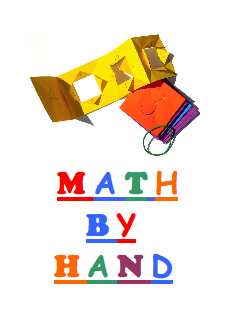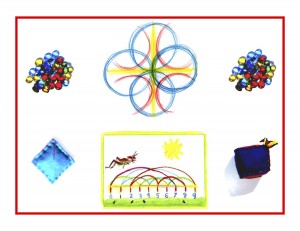
Day 44
For one year, 365 days, this blog will address the Common Core Standards from the perspective of creating an alternate, ambient learning environment for math. Ambient is defined as “existing or present on all sides, an all-encompassing atmosphere.” And ambient music is defined as: “Quiet and relaxing with melodies that repeat many times.”
Why ambient? A math teaching style that’s whole and all encompassing, with themes that repeat many times through the years, is most likely to be effective and successful. Today’s post, a variety of voices proclaiming the wonder and value of fairy tales, will be a prelude to tomorrow’s story.
Albert Einstein
If you want your children to be brilliant, read them fairy tales. If you want them to be geniuses, read them more fairy tales.
When i examine myself and my methods of thought, I come to the conclusion that the gift of fantasy has meant more to me than any talent for abstract thinking.
Imagination is more important than knowledge. For knowledge is limited to all we now know and understand, while imagination embraces the entire world, and all there ever will be to know and understand. Logic will get you from A to B. Imagination will take you everywhere. The true sign of intelligence is imagination.”
Marie Curie
I am among those who think that science has great beauty. A scientist in his laboratory is not only a technician: he is also a child placed before natural phenomena which impress him like a fairy tale.
Hans Christian Anderson
Life itself is the most wonderful fairy tale of all.
CS Lewis
When I was ten, I read fairy tales in secret and would have been ashamed if I had been found doing so. Now that I am fifty, I read them openly.
Charles Dickens
In a utilitarian age, of all other times, it is a matter of grave importance that fairy tales should be respected.
Jewish Folk Saying
Don’t ask questions of fairy tales.
GK Chesterton
Fairy tales do not tell children that dragons exist. Children already know that dragons exist. Fairy tales tell children that the dragons can be killed.
My first and last philosophy, that which I believe in with unbroken certainty, I learned in the nursery . . . the things I believed most in then, the things I believe most now, are the things called fairy tales. This philosophy is that life is not only a pleasure but a kind of eccentric privilege.
Bruno Bettelheim
To everybody who has heard fairy tales, the image and feeling of being lost in a deep, dark forest are unforgettable.
Once children become better acquainted with fairy tales, the fearsome aspects seem to disappear, while the reassuring features become ever more dominant. The original displeasure of anxiety then turns into the great pleasure of anxiety successfully faced and mastered.
Rudolf Steiner
Just as the body needs to have nutritive substances circulating through the organism, the soul needs fairy tale substance flowing through its veins.
Because fairy tales belong to our innermost feeling and emotional life and to everything connected with it, they are of all forms of literature the most appropriate for children’s hearts and minds. It is evident that they are able to combine the richest wisdom with the simplest manner of expression . . . there is no greater art than this one, which traces the path from the unknown, unknowable depths of the soul to the charming and often playful fairy tale pictures.
Knowledge ensues in an environment dedicated to imaginative, creative knowing, where student and teacher alike surrender to the ensuing of that knowledge as a worthy goal. Tune in tomorrow for a wonderful Kindergarten fairy tale farewell . . .

Tags:
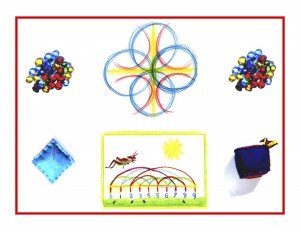
Day 43
For one year, 365 days, this blog will address the Common Core Standards from the perspective of creating an alternate, ambient learning environment for math. Ambient is defined as “existing or present on all sides, an all-encompassing atmosphere.” And ambient music is defined as: “Quiet and relaxing with melodies that repeat many times.”
Why ambient? A math teaching style that’s whole and all encompassing, with themes that repeat many times through the years, is most likely to be effective and successful. Today’s post will focus on the Standard for Mathematical Practice #8. It’s paired with yesterday’s (#7) standard as the last of four categories. These two are paired because they both focus on “Seeing structure and generalizing.”
This standard is almost exclusively intended for middle and high school students, with the exception of the first and last sentences, which appear here in blue, followed by just a few ambient comments and suggestions. I will also post the Common Core recommendations for connecting the Practice Standards with Content Standards.
Standards for Mathematical Practice
8. Look for and express regularity in repeated reasoning.
Mathematically proficient students notice if calculations are repeated, and look both for general methods and for shortcuts.
As they work to solve a problem, mathematically proficient students maintain oversight of the process, while attending to the details. They continually evaluate the reasonableness of their intermediate results.
In repeatedly using the materials provided in the free play segment of the Kindergarten day, many opportunities arise for noticing consistency. Objects like the counting stones and beans and jars are used again and again to add and subtract. This makes the general method and purpose clear, paving the way for more complex operations later on (which will most likely include shortcuts). This consistency also provides a general oversight of the process, with predictable and dependable results. Results are perceived as reasonable and immediate, but the way is also paved for working with intermediate results in future. Since this requires flexible thinking, a foundation is solidly built now, using a variety of tools and materials to gain the same consistent results: whether adding or subtracting with counting stones, sticks, flags, or beans.
Connecting the Standards for Mathematical Practice to the Standards for Mathematical Content: The Standards for Mathematical Practice describe ways in which developing student practitioners of the discipline of mathematics increasingly ought to engage with the subject matter as they grow in mathematical maturity and expertise throughout the elementary, middle, and high school years. Designers of curricula, assessments, and professional development should all attend to the need to connect the mathematical practices to mathematical content in mathematics instruction.
The Standards for Mathematical Content are a balanced combination of procedure and understanding. Expectations that begin with the word “understand” are often especially good opportunities to connect the practices to the content. Students who lack understanding of a topic may rely on procedures too heavily. Without a flexible base from which to work, they may be less likely to consider analogous problems. represent problems coherently, justify conclusions, apply the mathematics to practical situations, use technology mindfully to work with the mathematics, explain the mathematics accurately to other students, step back for an overview, or deviate from a known procedure to find a shortcut. In short, a lack of understanding effectively prevents a student from engaging in the mathematical practices.
In this respect, those content standards which set an expectation of understanding are potential “points of intersection” between the Standards for Mathematical content and the Standards for Mathematical Practice. these points of intersection are intended to be weighted toward central and generative concepts in the school mathematics curriculum that most merit the time, resources, innovative energies, and focus necessary to qualitatively improve the curriculum, instruction, assessment, professional development, and student achievement in mathematics.
All well and good, but I’m afraid that the bumps in the road the Common Core is experiencing as it’s implemented in the states are more than just the fact that it’s all so new, along with the reassurance that teachers, parents, and students alike will experience its merits and advantages down the road: a road that promises college and careers for all. There are too many overwhelmed children and parents, and teachers afraid of recrimination or dismissal if they don’t follow the directives of the standards, to put this widespread dissent down to only adjustment or recalcitrance. Read the above standard carefully to find its worthiness, but read it critically and between the lines to see the Common Core’s challenges and difficulties.
We will spend some time tomorrow and the next day looking at the nurturing stories told in the Waldorf Kindergarten, along with reflections on their value and merit. Copy and paste the link at the bottom of this post to read Hans Christian Anderson’s wonderful tale about the Emperor who was deceived by clever words and actions into believing his garments were substantial and exceptional.
Knowledge ensues in an environment dedicated to imaginative, creative knowing, where student and teacher alike surrender to the ensuing of that knowledge as a worthy goal. Tune in tomorrow: all about fairy tales in the Kindergarten.
http://www.andersen.sdu.dk/vaerk/hersholt/TheEmperorsNewClothes_e.html
Tags:

Day 42
For one year, 365 days, this blog will address the Common Core Standards from the perspective of creating an alternate, ambient learning environment for math. Ambient is defined as “existing or present on all sides, an all-encompassing atmosphere.” And ambient music is defined as: “Quiet and relaxing with melodies that repeat many times.”
Why ambient? A math teaching style that’s whole and all encompassing, with themes that repeat many times through the years, is most likely to be effective and successful. Today’s post will focus on the Standard for Mathematical Practice #7. It’s paired with tomorrow’s (#8) standard as the last of four categories. These two are paired because they both focus on “Seeing structure and generalizing.”
Most of standard #7 focuses on the middle and high school levels, so just the portions pertaining to Kindergarten will be the focus for today’s post. The standard will appear in blue, and a summary of its ambient counterparts along with references to where the lessons and activities may be found in this blog will follow.
Standards for Mathematical Practice
7. Look for and make use of structure.
Mathematically proficient students look closely to discern a pattern or structure.
Underlying pattern and structure lies at the very heart of math. The Waldorf curriculum deeply focuses on this, math’s most compelling and meaningful aspect. As such, this aspect is by far of the greatest interest to students and teachers, since a teacher who is excited and enthused about the subject at hand will be most successful at teaching it. A focus on pattern and structure begins in the Kindergarten, with observations in nature, rhythmic recitation and movement, and an awareness of the cycles of time, to name just a few. In math, a thorough and basic foundation is built with materials that are introduced in a structured way then made available for free play.
Young students, for example, might notice that three and seven more is the same amount as seven and three more,
Many blog posts address this. For example, the beans and jars on Day 4, the counting stones on Day 5, the written numbers in sand or on slate with water on Day 6, the circles and flags on Day 9, a knotted rope on Day 10, all show pattern in numbers and the various ways they come together. Parallel comparisons like the one mentioned above can easily happen with any of these delightful hands-on materials. And allow me to repeat that tremendous value lies in partnering with the child(ren) to make their own learning materials!
or they may sort a collection of shapes according to how many sides the shapes have.
This can be taken to an even more complex level with the activities suggested on Day 16. The sandpaper and wooden flat shapes allow for an in-depth look at how the shapes compare. For example, with the wooden triangle superimposed on the sandpaper square, lines and numbers of sides become immediately and very experientially clear. In the math corner free play with the “guess the shapes” pouch, the child(ren) will most likely sort and compare the shapes as described above. Creating large models of the shapes by outlining them with string and pegs on the ground affords another opportunity to explore and compare shapes.
They recognize the significance of an existing line in a geometric figure and can use the strategy of drawing an auxiliary line for solving problems.
For this, only a deep, experiential, and foundational approach that will reappear in a more advanced mode is appropriate in the Kindergarten. Creating large models of the squares, triangles, and hexagons by outlining them with string and pegs on the ground affords an excellent opportunity to explore the lines and overall structure of shapes. Day 18 offers this activity along with one that’s similar but also creates an awareness of the character differences of the shapes by walking them with dialog like, “Around, around, and around, a circle!” or, “Walk-stop-walk-stop-walk-stop-walk-stop, a square!”
These foundational roots flower into form drawing in the first through fifth grades, then beautifully constructed geometric forms in the sixth grade. The form above is an example of a grade 2 form drawing, focusing on horizontal and vertical symmetry. This brings us back full circle to the deep focus in Waldorf Education: the archetypal forms found all around us and in nature. These forms resonate very deeply with the children. I taught form drawing every Monday in my Waldorf second grade class, and more often than not after formally learning and drawing the form, the children would spontaneously draw it over and over on the chalkboard during recess. See below for my daughter’s sixth grade geometric drawing of a pentagram.
Knowledge ensues in an environment dedicated to imaginative, creative knowing, where student and teacher alike surrender to the ensuing of that knowledge as a worthy goal. Tune in tomorrow for the Kindergarten Standard for Mathematical Practice #8.

Tags:
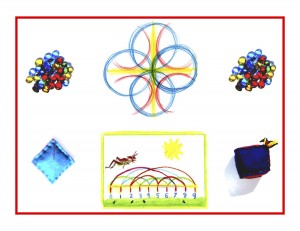
Day 41
For one year, 365 days, this blog will address the Common Core Standards from the perspective of creating an alternate, ambient learning environment for math. Ambient is defined as “existing or present on all sides, an all-encompassing atmosphere.” And ambient music is defined as: “Quiet and relaxing with melodies that repeat many times.”
Why ambient? A math teaching style that’s whole and all encompassing, with themes that repeat many times through the years, is most likely to be effective and successful. Today’s post will focus on the Standard for Mathematical Practice #5. It’s paired with yesterday’s (#4) standard as the third of four categories. These two are paired because they both focus on “modeling and using tools.”
Most of this standard focuses on the middle and high school levels, so just the portion that pertains to younger grades will be the focus for today’s post. The standard will appear in blue, and a summary of its ambient counterparts will follow.
Standards for Mathematical Practice
5. Use appropriate tools strategically.
Mathematically proficient students consider the available tools when solving a mathematical problem. These tools might include pencil and paper, concrete models or a ruler. Proficient students are sufficiently familiar with tools appropriate for their grade or course to make sound decisions about when each of these tools might be helpful, recognizing both the insight to be gained and their limitations. Mathematically proficient students at various grade levels are able to identify relevant external mathematical resources, such as digital content located on a website, and use them to pose or solve problems. They are able to use technological tools to explore and deepen their understanding of concepts.
Beginning at the end, a word about technology. It seems there’s currently a push to have every school wired and every student equipped with the means to learn independently through the internet, on pads and tablets. The road to the prospect of a teacherless classroom has already been set in place by having today’s teachers so preoccupied with data collection that attention to students’ needs and helping them apply their native talents and abilities has been given short shrift.
The use of technology has become more widespread, even among pre-schoolers. A myriad of apps can be educational or simply engaging and entertaining, but the question of whether it’s appropriate or healthy for very young children to use technology is still an open one and up for debate. I remember my daughter at 2 or 3 staring open-mouthed at the TV, and my mother-in-law saying, “Mothers are so lucky these days. They get to use the TV to keep their kids busy.” At the time, it didn’t sit right for me in a general way, but with today’s additional information and widespread use of devices, I am clearer on why it doesn’t work.
Having just seen the film “Her,” about a man and his OS (Operating System) who fall in love(!) with each other, I was chilled by this image: crowd scenes of people who seemed to be talking to themselves, but were actually communicating with other people (or with their devices) on their devices. Children (and the rest of us) need human connection. Is there anything sadder than a child trying to get a mother’s attention as she is zeroed in on a device?
Sorry for the rant but it’s a big issue and it’s all of a piece, feeding into more and more automated, removed models of education. Back to the standard, beginning at the beginning: available tools for the Kindergarten would be rhymes and songs that are learned by heart with rhythm instruments to accompany them, all the learning materials suggested in earlier blog posts like natural objects used for counting (stones, acorns, shells), hand-made (with the children’s help) learning materials, like the counting flags, 3-D cloth models, sandpaper shapes, just to name a few.
As the children use the materials made available to them in the Math Corner, they begin to see them as tools to solve mathematical problems, translating addition and subtraction to a written representation on paper, using operation signs appropriately. Having the various tools available in the Math Corner promotes a sufficient familiarity with them, and with a teacher or parent’s guidance, the child(ren) become better able to discern both the helpfulness and limitations of these tools.
At the risk of going against a rising tide, I must say that young children using apps puts them at a disadvantage on many fronts. Children in the Waldorf school do not learn about, or on, a computer until they are able to build a rudimentary one themselves. The early grades are decidedly low-tech, with lessons learned first hand. The children create their own books, by recording each day what’s been learned in that day’s main lesson. And the human-to-human connection, child to adult, is always, always paramount.
I will let Anne Sullivan, Helen Keller’s indomitable teacher, have the last word. She said, “The wrong things are predominantly stressed in the schools – things removed from the student’s experience and need.” “My heart is singing for joy this morning! A miracle has happened! The light of understanding has shone upon my little pupil’s mind, and behold, all things are changed!” “Children require guidance and sympathy much more than instruction.” Anne Sullivan is called a miracle worker, but it is no more miracle than any teacher or parent can create with his or her child(ren), if but left free to find the right relationship to education and the child.
Knowledge ensues in an environment dedicated to imaginative, creative knowing, where student and teacher alike surrender to the ensuing of that knowledge as a worthy goal. Tune in tomorrow for the Kindergarten Standard for Mathematical Practice #7.
And because a picture is worth a thousand words, here they are, teacher and student:
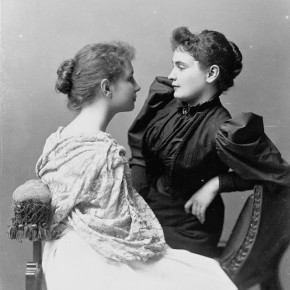
Tags:
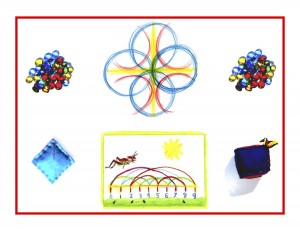
Day 40
For one year, 365 days, this blog will address the Common Core Standards from the perspective of creating an alternate, ambient learning environment for math. Ambient is defined as “existing or present on all sides, an all-encompassing atmosphere.” And ambient music is defined as: “Quiet and relaxing with melodies that repeat many times.”
Why ambient? A math teaching style that’s whole and all encompassing, with themes that repeat many times through the years, is most likely to be effective and successful. Today’s post will focus on the Standard for Mathematical Practice #4. It’s paired with tomorrow’s (#5) standard as the third of four categories. These two are paired because they both focus on “modeling and using tools.”
As the creator of Math By Hand, and as a naturally can-do, hands-on person, I will find many aspects in common with today’s standard. It will appear in blue, followed by references to the blog posts aligned with it. All references that apply to older grades will be omitted.
Standards for Mathematical Practice
4. Model with mathematics.
Mathematically proficient students can apply the mathematics they know to solve problems arising in everyday life, society and the workplace. In early grades, this might be a simple as writing an addition equation to describe a situation.
A perfect example of this, storytelling to present and solve problems, can be found in the Day 10 and 12 posts, thanks to Peter Rabbit and Squirrel Nutkin. Aspects are taken from stories that have been told and are well known by the child(ren). Hands-on models are used to represent elements of the story, drawings made to illustrate the problem, and math then describes and or resolves the situation. This activity can evolve into solving word problems in the later grades. But a word of caution here. Please be sure that word problems are reality-based! Nothing is more alienating than being asked to solve a problem that has no point and / or any real meaning.
Mathematically proficient students who can apply what they know are comfortable making assumptions and approximations to simplify a complicated situation, realizing that these may need revision later.
As stated in yesterday’s post, the free play engaged in by Kindergarteners offers a myriad of opportunities to do just this every day, many times a day. Negotiations are the backbone of this sort of play. Children routinely do this, either with each other or when one child is playing alone, s/he will have complicated, intricate discussions with an imaginary friend or with him or herself! If enough free play is allowed, a very sturdy foundation is built, upon which excellent academic skills are added later. The math materials that are created and used with activities in all of these blog posts, and stored in the math corner after a brief introduction make this sort of math play possible.
They routinely interpret their mathematical results in the context of the situation and reflect on whether the results make sense, possibly improving the model if it has not served its purpose.
This trial and error approach is routinely applied again and again, in the context of free play. If nurtured and left to take root in early childhood, play will later flower into a flexible and creative way of thinking. The hands-on materials suggested throughout this blog’s posts will most effectively afford the opportunity to creatively “play” with math.
Albert Einstein said, “Play is the highest form of research.” And, “Creativity is the residue of time wasted.” And, “I have no special talents, I am only passionately curious.” And finally, “It is nothing short of a miracle that the modern methods of education have not yet entirely strangled the holy curiosity of inquiry. It is a very grave mistake to think that the enjoyment of seeing and searching can be promoted by means of coercion and a sense of duty.” Let the little ones at least, play!
Knowledge ensues in an environment dedicated to imaginative, creative knowing, where student and teacher alike surrender to the ensuing of that knowledge as a worthy goal. Tune in tomorrow for the Kindergarten Standard for Mathematical Practice #5.
Tags:
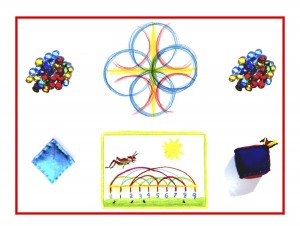
Day 39
For one year, 365 days, this blog will address the Common Core Standards from the perspective of creating an alternate, ambient learning environment for math. Ambient is defined as “existing or present on all sides, an all-encompassing atmosphere.” And ambient music is defined as: “Quiet and relaxing with melodies that repeat many times.”
Why ambient? A math teaching style that’s whole and all encompassing, with themes that repeat many times through the years, is most likely to be effective and successful. Today’s post will focus on the Standard for Mathematical Practice #3. It’s paired with yesterday’s (#2) standard as the second of four categories. These two are paired because they both focus on “reasoning and explaining.”
Before blogging tonight, I explored the web for examples of how teachers are applying this particular standard in Kindergarten and Grade 1. My overall impression is that teachers are working hard to match lesson plans with requirements. And that the whole may be suffering at the expense of attending to the parts.
Shouldn’t the standards take a back seat, as a tool for assessment after the teacher has been given free reign to teach the basics as s/he sees fit? Rather, they seem to be very much front end, requiring diligent attention to their many and detailed facets, driving the lesson planning and day to day interaction with the children. The result is not spontaneous, lively or joyful.
After watching these creative teachers’ competent efforts to fit their lesson planning to the standards’ requirements, I experienced a familiar feeling: self-doubt. Am I writing in a vacuum? Am I disillusioned about what should be the backbone of teaching and education? Have I heard too many one-sided opinions, those of parents and teachers who are dismayed and defeated by the Common Core? I can only hope that this self-doubt is a result of my unwarranted fear, and that my voice on this topic is a valuable one.
Today’s post will be relatively brief. The standard will appear in blue in its entirety, omitting obviously advanced elements. All the suggested activities are potentially applicable to this standard so brief, general guidelines will be listed after it.
Standards for Mathematical Practice
3. Construct viable arguments and critique the reasoning of others.
Mathematically proficient students understand and use stated assumptions, definitions, and previously established results in constructing arguments. They make conjectures and build a logical progression of statements to explore the truth of their conjectures. They justify their conclusions, communicate them to others, and respond to the arguments of others. They reason inductively about data, making plausible arguments that take into account the context from which the data arose. Elementary students can construct arguments using concrete referents such as objects, drawings, diagrams, and actions. Such arguments can make sense and be correct, even though they are not generalized or made formal until later grades.
The Kindergarten free play time affords a wealth of opportunity for this sort of reasoning and argument. As the child(ren) engage in play they practice real world experiences. If you observe children (or even a single child) in play, you will see constant reasoning and argument, since they are trying on ways to live in the world that are in large part imitation, but also the innovation that surfaces from their own budding consciousnesses.
It’s just a short leap from this more general play to math. All of the materials that were gently introduced then placed in the math corner for free play will generate this sort of interaction. The teacher can gently intervene at times to observe and prompt. But you will find that all the points covered in this standard are quite native to the young child and will surface of themselves.
Though this is a general review, I trust that you will find your way to apply it in tandem with the suggested activities without too much difficulty. I am prompted to include this excerpt from William Wordsworth’s poem, “Intimations of Immortality” with the fervent hope that we will see (and trust, in faith) these “trailing clouds of glory” in all of our children.
“Our birth is but a sleep and a forgetting:
The soul that rises with us, our life’s Star,
Hath had elsewhere its setting,
And cometh from afar:
Not in entire forgetfulness,
And not in utter nakedness,
But trailing clouds of glory do we come
From God, who is our home:
Heaven lies about us in our infancy!
Shades of the prison-house begin to close
Upon the growing Boy,
But he beholds the light, and whence it flows,
He sees it in his joy . . . ”
Knowledge ensues in an environment dedicated to imaginative, creative knowing, where student and teacher alike surrender to the ensuing of that knowledge as a worthy goal. Tune in tomorrow for the Kindergarten Standard for Mathematical Practice #4.
Tags:
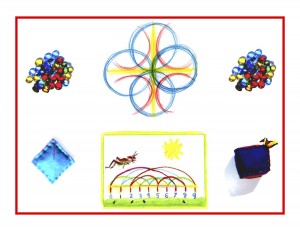
Day 38
For one year, 365 days, this blog will address the Common Core Standards from the perspective of creating an alternate, ambient learning environment for math. Ambient is defined as “existing or present on all sides, an all-encompassing atmosphere.” And ambient music is defined as: “Quiet and relaxing with melodies that repeat many times.”
Why ambient? A math teaching style that’s whole and all encompassing, with themes that repeat many times through the years, is most likely to be effective and successful. Today’s post will focus on the Standard for Mathematical Practice #2. It’s paired with tomorrow’s (#3) standard as the second of 4 categories. These two are paired because they both focus on “reasoning and explaining.”
Blaise Pascal, a French mathematician, physicist, inventor, writer, and religious philosopher, invented the first digital calculator (adding machine) called the Pascaline, in 1642 to aid his father, a mathematician and tax collector. Pascal said, “The heart has its reasons which reason knows nothing of . . . We know the truth, not only by the reason but by the heart.”
Quite parallel to the philosophy and methodology of Waldorf Education, this says that a true education must draw from the wells of feeling and willing as well as thinking, which makes the human being whole. Translation re this standard: though it is necessary to reason abstractly and quantitatively, educators must not lose sight of the necessity to reason concretely and qualitatively when educating the young child. With that in mind, let’s dive in. Today’s standard is more dense and complex, therefore it will need to be broken up into smaller parts. The parts of the standard will appear in blue, and its ambient counterparts will follow.
Standards for Mathematical Practice
2. Reason abstractly and quantitatively.
Mathematically proficient students make sense of quantities and their relationships in problem situations.
As previously stated, making sense could have an expanded meaning here, in that all of the senses are fully engaged in math processing. And in order to fully apprehend relationships in problem situations, quantities must relate to qualities. A good example of this is the greater-less than sign introduced on Day 6 of this blog. The quality of greater is communicated by the wide open hand, while the quality of less than is shown as it diminishes to nothing. In the Waldorf first grade, the 4 processes are connected with the four temperaments, so as the children compute, they can get a sense of the processes’ deeper nature in how they relate to themselves and each other.
They bring two complementary abilities to bear on problems involving quantitative relationships: the ability to decontextualized – to abstract a given situation and represent it symbolically and manipulate the representing symbols as if they have a life of their own, without necessarily attending to their referents –
Whew, now that’s a mouthful. I am having trouble seeing a well-intentioned, very capable, nurturing Kindergarten teacher (or homeschooling parent) taking this to heart and translating it into coherent, lively lesson plans. With the painful consciousness that this requirement will be translated into questions on a test that s/he needs to be teaching towards. It takes time for a child to grow into him or herself sufficiently to be able to handle abstract symbols, since consciousness of the young child is concrete by nature. That is why I’ve recommended that numerical symbols (the Arabic numerals) not be used in Kindergarten, because it’s too great a leap from . . to 2. the Day 6 and Day 11 posts focus on how to add and subtract using counting lines rather than numbers. The symbols do indeed have a life of their own, and that goes for letters as well as numbers. Numbers are introduced in the first grade in conjunction with stories and geometric forms, to demonstrate their individual “personalities,” making math more friendly and approachable while giving the number symbols their due. All of the posts reviewed in the Free Play segment, Days 24-26, reflect an attention to gradually instilling a consciousness for calculation.
– and the ability to contextualize, to pause as needed during the manipulation process in order to probe into the referents for the symbols involved.
There’s little need to recontextualize if decontextualizing is minimal to nil. It can be all of a piece, with manipulation happening only in context. By the way, in the Waldorf system all 4 processes are introduced at once, very simply, in the first grade so that the whole picture is given from the very beginning.
Quantitative reasoning entails habits of creating a coherent representation of the problem at hand; considering the units involved,
All of the blog posts reviewed on Days 24-26 demonstrate coherent representations of calculation: counting stones, beans, shells and acorns, circles and sticks or flags, stories, and relevant movement.
attending to the meaning of quantities, not just how to compute them,
The jars and beans suggested in the Day 4 post build a foundation for an awareness of the unique quantity (and quality) of each number.
and knowing and flexibly using different properties of operations and objects.
All of the posts mentioned above (Days 24-26) attend to this, but especially Day 11. The operations signs for plus and minus are introduced as “and” and “take away” and the equal sign is introduced as “is” enabling calculation with objects.
Knowledge ensues in an environment dedicated to imaginative, creative knowing, where student and teacher alike surrender to the ensuing of that knowledge as a worthy goal. Tune in tomorrow for the Kindergarten Standard for Mathematical Practice #3.
Tags:
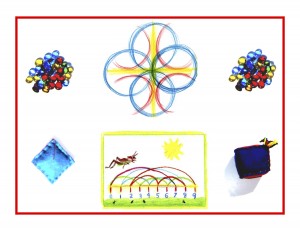
Day 37
For one year, 365 days, this blog will address the Common Core Standards from the perspective of creating an alternate, ambient learning environment for math. Ambient is defined as “existing or present on all sides, an all-encompassing atmosphere.” And ambient music is defined as: “Quiet and relaxing with melodies that repeat many times.”
Why ambient? A math teaching style that’s whole and all encompassing, with themes that repeat many times through the years, is most likely to be effective and successful. Today’s post will focus on the Standard for Mathematical Practice #6. It’s paired with yesterday’s (#1) standard as the first one of 4 categories because they both express “overarching habits of mind of a productive mathematical thinker.”
Just reading that sentence prompts me to confess that I am not a math person, never was. I probably suffered from all possible math phobias, scrupulously avoiding the subject wherever and whenever possible. It wasn’t until I discovered Waldorf Education at the Institute in Spring Valley where I trained to be a Waldorf class teacher, that I found a wonderful (and welcoming) doorway into the beauty of math.
Rudolf Steiner himself, as he was staffing the first Waldorf school in Stuttgart, chose an experienced historian to teach math (or it may have been the other way around). Upon hearing the hapless teacher’s protest, Steiner said something to the effect that if he were striving to learn the subject several steps ahead of the students, it would serve as a most valuable asset, imbuing his teaching with enthusiasm for the subject.
That story gave me the courage to plunge into math along with other “weak” areas: music and singing, knitting, and science. My point here is that math, of all subjects, does not like to be taught directly, in a one-dimensional abstract mode. It needs to be embedded in the things of nature and the world. It may be best for the “overarching habits of mind” to not be solely focused on numbers and their relationship, and for the productiveness to spill over into a myriad of areas along with the numbers.
Albert Einstein, arguably the greatest mathematician ever, said not to worry about your troubles with mathematics – his were still greater. And his legacy is a veritable feast of philosophical and spiritual insights. He was not “nose to the grindstone” when he discovered the theory of relativity, but had all of the speculative calculations secreted away in his desk drawer at the Swiss Patent Office, working on them when he could, in the midst of an entirely different career. Math does not like to be approached directly, and this leads back to the concept of ambient math.
Today’s post will be structured somewhat differently than yesterday’s. The standard will be broken up into parts, a sentence at a time in blue, followed by each one’s ambient Kindergarten counterparts. References to higher mathematics will again be omitted. Yesterday’s post on the #1 standard was somewhat generalized, but I will be focusing more specifically today on the activities that directly relate.
Standards for Mathematical Practice
6. Attend to precision.
Mathematically proficient students try to communicate precisely to others.
Math is a universal language. As such, its particulars can be communicated to others in an understandable way. In the Kindergarten free play, both indoors and out, this sort of communication is continually practiced, in the interests of working together productively to produce a community project. This communication can also happen with math. For example, after the glass jars and beans have been introduced (Day 4 of this blog), they can be used communally, with clear communication and precision.
They try to use clear definitions in discussion with others and in their own reasoning.
“Discussion” could be broadened here to include other forms of communication. The time spent with shapes, in the free play, circle time, and outside segments fill this bill nicely. Days 16, 17, 18, and 19 focus on a variety of group activities with shapes: tossing and catching the fabric versions while saying their names, repeating the name of a circle, square, or triangle as it’s traced with string, discerning, together with a partner, whether an object is flat or solid are a few examples among many.
They state the meaning of the symbols they choose, including using the equal sign consistently and appropriately.
See Day 6 for a graphic, pictorial introduction of the greater / less than signs and Day 11 for addition, subtraction, and equal signs. Although the names are different (“and” for addition, “take away” for subtraction, and “is” for the equal sign) their functions are unmistakable. After the concepts and signs are introduced, the math may be practiced with objects.
They are careful about specifying units of measure.
Days 13, 14, and 15 focus on measurement with cooking and categorizing/sorting.
They calculate accurately and efficiently, express numerical answers with a degree of precision appropriate for the problem context.
Though at this level, calculation occurs with objects and symbols, it is consistently accurate. If the activities are carefully conceived and demonstrated, they will always result in the correct numerical answers. As stated throughout, though abstraction is not yet in place, strong foundations are laid for future mathematics success.
In the elementary grades, students give carefully formulated explanations to each other.
Circle time is the perfect venue for this since the group activities, if organized and orchestrated carefully, can express just such formulated explanations though joyful group activities. See Days 30 and 31’s posts for a summary of how the standards can be integrated into circle time.
Knowledge ensues in an environment dedicated to imaginative, creative knowing, where student and teacher alike surrender to the ensuing of that knowledge as a worthy goal. Tune in tomorrow for the Kindergarten Standard for Mathematical Practice #2.
Tags:
Day 36
For one year, 365 days, this blog will address the Common Core Standards from the perspective of creating an alternate, ambient learning environment for math. Ambient is defined as “existing or present on all sides, an all-encompassing atmosphere.” And ambient music is defined as: “Quiet and relaxing with melodies that repeat many times.”
Why ambient? A math teaching style that’s whole and all encompassing, with themes that repeat many times through the years, is most likely to be effective and successful. In reviewing the Standard for Mathematical Practice #1, I find that these standards are too dense and complex to include two of them in one blog post. Today will be #1, tomorrow #6, and the other three pairs will follow. The standard will be broken up into parts, a sentence at a time (in blue), followed by their ambient Kindergarten counterparts. I will of course be omitting references to higher mathematics since they are irrelevant here.
Standards for Mathematical Practice
1. Make sense of problems and persevere in solving them.
Mathematically proficient students start by explaining to themselves the meaning of a problem and looking for entry points to its solution.
We could begin by taking the word “sense” quite literally, by applying it to the senses. If the math problem is approached in a sensory way, it’s operated upon by more than just the intellect, so the heart and hands have a fair say in the solution as well. Perhaps we should even question the use of the word “problem” in relation to math. In the Kindergarten it may be more appropriate to think of the problems as phenomena to be observed and marveled at first. The best, most creative minds and hearts throughout history learned through just this sort of acute observation. If the two parameters of learning through the senses and attentive observation are employed, it may be possible for Kindergartners to explain the meaning of the phenomena to themselves and look for how it may resolve itself, albeit with some help and guidance.
They analyze givens, constraints, relationships, and goals.
At this level, all of these qualities are inherent in the way the material is presented. The Kindergartner takes any given, constraint, relationship, or goal that is implied in any situation on faith and trust, so it’s incumbent upon the teacher to communicate those qualities in an age-appropriate way, keeping in mind that play is paramount now and reserving academics for later is usually better.
They make conjectures about the form and meaning of the solution and plan a solution pathway rather than simply jumping into a solution attempt.
Kindergartners do this every time they engage in play, beginning a course of action in response to a problem and not hesitating to change or regroup if necessary until a solution is found. If allowed to fully play this out, an unshakable foundation is built, later translating this process to academics. It is best if play and creativity stay alive and well throughout, informing all academic endeavors with their bright color and art.
They consider analogous problems, and try special cases and simpler forms of the original problem in order to gain insight into its solution.
This again is a quality endemic to all serious play, and as stated above, if allowed free reign until age 7, will build the sturdiest foundation for later learning. Regarding math at this age, most concepts will be made accessible by their concreteness and sensory approach, so the child(ren) will enter on math’s ground floor and progress to its higher levels gradually and with much support.
They monitor and evaluate their progress and change course if necessary.
May I say here that the “teaching to the test” employed in most schools and at all levels at this time is not a good venue for this sort of free trial and error exploration. If the primary (and in some cases only) goal is to pass the test, real learning cannot happen in a healthy way. If the Kindergarten ambient math materials are made available in the free play area after they are demonstrated, this sort of play learning and exploration may very well take place.
Younger students might rely on using concrete objects or pictures to help conceptualize and solve a problem.
All of the ambient materials suggested here meet this description, and problems may be conceptualized and solved in the context of free play, as described above.
Mathematically proficient students check their answers to problems using a different method, and they continually ask themselves, “Does this make sense?”
This will happen at this age within careful guidelines provided by the teacher. The same concept is continually presented in different ways and it becomes obvious that the same result can be obtained through different means. It becomes clear that the methods used make good sense if a secure scaffolding is maintained throughout.
They can understand the approaches of others to solving complex problem s and identify correspondences between different approaches.
As mentioned above, all concepts are consistently presented in a multifaceted and diverse way. Another solid foundation is built here: the recognition of the fact that others’ thoughts, approaches, and methods are equally valid. This develops into a healthy awareness of the correspondences between different approaches. Good citizenship too can be extrapolated from this realization, which brings another important point to light. That good teaching and learning by their very nature always have a strong moral fiber.
Knowledge ensues in an environment dedicated to imaginative, creative knowing, where student and teacher alike surrender to the ensuing of that knowledge as a worthy goal. Tune in tomorrow for the Standard for Mathematical Practice #6.
Tags:
Day 35
For one year, 365 days, this blog will address the Common Core Standards from the perspective of creating an alternate, ambient learning environment for math. Ambient is defined as “existing or present on all sides, an all-encompassing atmosphere.” And ambient music is defined as: “Quiet and relaxing with melodies that repeat many times.”
Why ambient? A math teaching style that’s whole and all encompassing, with themes that repeat many times through the years, is most likely to be effective and successful. Before moving on to the four pairs of Mathematical Practice Standards, I’d like to take some time today to highlight the three principles that form the foundation of the CA CCSSM. These three principles will appear in blue, and their suggested ambient counterparts will follow.
1. Focus. Means that instruction should focus deeply on only those concepts that are emphasized in the standards so that students can gain strong foundational conceptual understanding, a high degree of procedural skill and fluency, and the ability to apply the mathematics they know to solve problems inside and outside the mathematics classroom.
Rudolf Steiner, the founder of Waldorf Education, said, “Receive the children with reverence, educate them with love, and send them forth in freedom.” Freedom is the hallmark of a true education, and it cannot find a place in the current strictures that demand the narrow focus stated above. These demands on teachers, parents, and children alike, strangle the flexibility and creativity that enables great teaching and learning. Faith and trust are implicit in a system that honors its teachers’ (and parents’ and children’s for that matter) judgment and ability to excel, employing the dynamic, exciting ideas that flower from a free and creative approach.
Cross curricular teaching and learning, in vogue at one time, seems to be frowned upon in light of the fact that “instruction must focus deeply on only those concepts that are emphasized in the standards.” the Waldorf method of introducing the numbers 1-12 in a personal way in the first grade via connections with a unique fairy tale and a geometric form for each one surely violates this idea of focus. But at the same time, an alternative sort of focus can enable an entirely different kind of depth, one that is multi-faceted, sparking a comfortable familiarity and confidence with numbers and math.
2. Coherence. Arises from mathematical connections. Some of the connections in the standards knit topics together at a single grade level. Most connections are vertical, as the standards support a progression of increasing knowledge, skill, and sophistication across the grades.
This concept resonates with the “spiral” method employed in most Waldorf schools. And this is a good, since it builds confidence and meaning. For instance, factors could be introduced very early on, colorfully and with a supporting story that goes something like this, “The King of Numbers is 12. It’s rich with many jewels. But 13 is poor!” An illustration shows 12’s factors (1, 2, 3, 4, 6, and 12) contrasted with 13’s factors (1 and 13). The story and image serve as anchors for the concept, and when factoring repeatedly returns, vertically with increasing knowledge, skill, and sophistication, it’s met with confidence and readiness. I would though, expand this to include connections across the curriculum with language, art, games and movement, in a much more concrete and much less abstract mode.
3. Rigor. Requires that conceptual understanding, procedural skill and fluency, and application be approached with equal intensity.
Rigor does not seem like a good thing in the early grades. I found three definitions for rigor in my little Mac dictionary: 1. strictness, severity, stringency, toughness, rigidity, inflexibility, intransigence. 2. meticulousness, thoroughness, carefulness, diligence, scrupulousness, exactness, exactitude, precision, accuracy, correctness, strictness. 3. hardship, harshness, severity, adversity; ordeal, misery trial; discomfort, inconvenience, privation. I am sure that #2 is the one espoused by the Common Core Standards. But I am uncomfortable with the fact that #’s 1 and 3 definitions are so close to #2’s. And if you look closely at #’s 1 and 3, you will notice a resemblance to a lot of the distress and disagreement coming forward from teachers, parents, and children in regard to teaching to these standards and then applying the accompanying difficult and rigorous tests.
As for the idea that an equal emphasis be placed on these three: understanding, skills and fluency, and application, it seems this balance would come about spontaneously with a method that embraces enthusiasm for the subject. Allow me an example from one of my Waldorf second graders. We had just experienced (with lots of lively movement, fun, and color) the patterns that the tables from 1-10 make on a 10 circle. The children were so surprised by and excited about the unusual patterns that occur on the circle, that many of them carried the idea home and created visual images of it. One boy brought in a very large paper with all of the patterns superimposed in different colors. His enthusiasm enabled all three of the above, without any special effort on my (or his) part. It flowed, and that’s what story, art, and movement will bring to math, every time.
In closing, a couple stories re the Common Core. Today I talked to a grandparent about her grandson’s parents’ choice of schools. She said that they were considering a new school that was rated 9 out of 10 based on test scores. However, they love his current school which is only rated 3 out of 10, again based on test scores. She added that when parents were asked to rate their schools using a 5-star system, the schools that ranked the highest happened to have the lowest test scores. What does this say, and shouldn’t we be listening?
Google delivers ads for things it thinks we want, on the sidebars of its web pages. I saw one today that said “Common Core Curriculum for Grade 2.” So I explored the site and found that the curriculum was all digital, applicable only to iPads, Android tablets, etc., strictly structured on standards content, and that it claimed to be engaging and interesting. (I question this about any activity if all it requires is staring at a screen and moving only your right index finger to click the mouse.) On checking some of the lesson samples, I found the pages were bare fact based, multiple choice, and with a robotic, computer voice over. I connected this with something President Obama is advocating, that all schools will be wired in the near future, and came up with this image. A roomful of 7-8 year olds sitting at their desks, each plugged into his/her own tablet with earphones, all day. No teacher needed . . . yikes!
Please remember that knowledge ensues in an environment dedicated to imaginative, creative knowing, where student and teacher alike surrender to the ensuing of that knowledge as a worthy goal. On to Kindergarten Mathematical Practice Standards tomorrow!
Tags:

